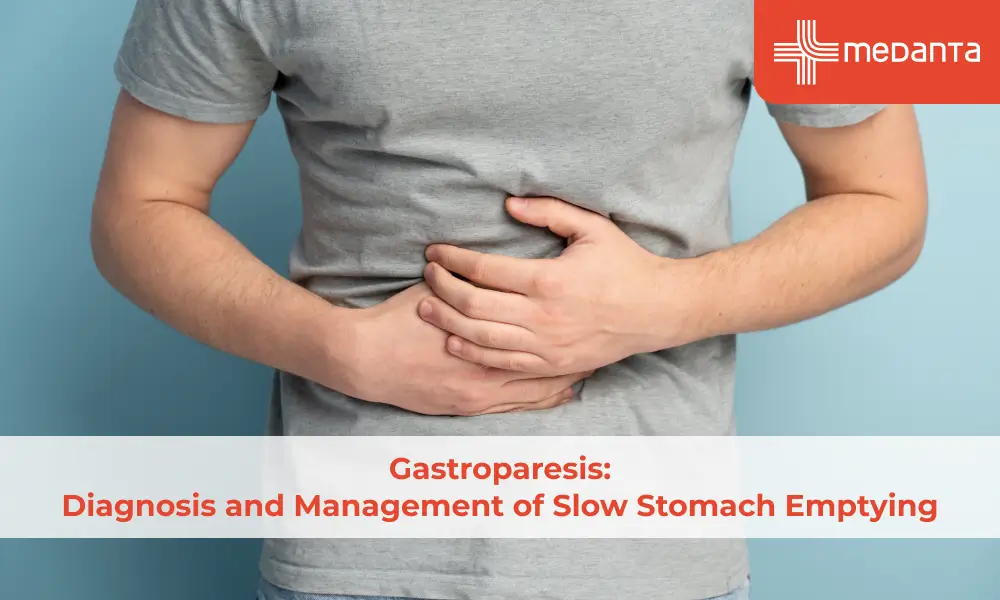Gastroparesis: Diagnosis and Management of Slow Stomach Emptying

TABLE OF CONTENTS
Gastroparesis disrupts the lives of roughly 4% of people, causing major problems in their daily routines and sometimes leading to severe disability. The condition stops the stomach from emptying its contents into the small intestine for at least three months.
Patients with gastroparesis struggle with nausea, vomiting and abdominal pain. The symptoms can range from mild discomfort to severe problems that need medical help. Its severity varies greatly among patients.
Doctors use specific procedures to diagnose gastroparesis correctly. Solid meal gastric scintigraphy remains the gold standard test to confirm the condition. The root causes vary widely - more than half the cases have no known cause (idiopathic), while diabetes, surgical complications, and infections trigger many others.
This article covers the complexities of gastroparesis diagnosis and shows you effective ways to manage it. You'll learn what it means to live with this challenging digestive disorder. Getting to know this condition better helps you handle its effects and improve your quality of life.
Understanding Gastroparesis and Its Causes
Gastroparesis means "stomach paralysis"—a name that perfectly describes this condition. The stomach's muscles become weaker and slower than normal. Regular rhythmic contractions that move food through the digestive system start to fail, which leads to much slower gastric emptying.
In this condition, food remains in the stomach much longer than the usual 2-4 hour transit time. The delayed food emptying happens without any physical blockage. That's what makes it different from many other digestive issues.
The root cause stems from damage to the vagus nerve—a communication highway connecting your brain and stomach. This significant nerve controls the muscles that move food forward. Damage to this nerve means your stomach can't process food or empty itself properly.
Several factors can damage this sensitive nerve:
People with diabetes usually develop this condition after living with the disease for ten years or more. High blood glucose levels damage nerves and blood vessels that feed the stomach. This creates ideal conditions to develop gastroparesis.
Surgical procedures around the stomach area can harm the vagus nerve.
Viral infections, especially norovirus and rotavirus
Medications - some pain relievers, antidepressants, and blood pressure medications slow down stomach emptying.
Autoimmune conditions like scleroderma can lead to gastroparesis.
Doctors cannot find the cause in many cases despite extensive investigations. These cases are called idiopathic gastroparesis.
Recognising the Symptoms and Complications

Life with gastroparesis brings a range of ongoing symptoms that affect daily activities. The symptoms usually start after eating and can linger for hours—or sometimes even days.
You might experience the following symptoms:
Nausea and vomiting (sometimes throwing up undigested food from hours ago)
Getting full quickly even when you haven't eaten much
Bloating and stomach distension
Abdominal pain and discomfort
Loss of appetite
Acid reflux and heartburn
Unexplained weight loss
Each person's experience differs. The intensity of symptoms doesn't always relate to how slowly food moves through the stomach. Some people deal more with feeling full early and stomach pain, while others struggle with nausea and vomiting.
When to Seek Immediate Medical Help
You need urgent medical attention if you experience:
Constant vomiting
Blood in vomit
Quick weight loss
Medical care becomes crucial if you feel extremely thirsty, notice less urination, dark urine, or feel lightheaded.
Gastroparesis can lead to serious complications:
Food buildup: Food sitting in your stomach for too long might form a hard mass called a bezoar. These masses can block food from passing through and cause severe symptoms that sometimes need surgery to remove.
Poor nutrition: People with gastroparesis often lack vitamins C, D, E, K, calcium, iron, and other key nutrients. These shortages happen because eating becomes difficult, which leads to avoiding food and inadequate nutrition.
Unpredictable blood sugar changes: In diabetic patients, sugar levels can spike without warning after food finally moves into the small intestine. This further makes diabetes harder to control.
Social impact: Not being able to enjoy meals with others often leads to feeling isolated, and this really cuts into the quality of life.
How do Doctors Diagnose Gastroparesis?
The diagnostic process starts with a complete medical history and physical exam. Doctors check the patient's signs of dehydration, malnutrition, and stomach tenderness.
Gastric emptying scintigraphy remains the most reliable way to diagnose this condition. The test works by tracking food movement through your stomach. You eat a meal with a small radioactive substance and lie under a scanner. The scanning process takes about four hours. This condition becomes clear if more than 10% of the meal stays in the stomach after four hours.
Doctors also use the following diagnostic tools:
Gastric emptying breath tests to track food movement speed
Wireless motility capsules
Upper endoscopy to check for blockages
Treatment of Gastroparesis
The main goal of treatment is to control symptoms and help food move through the stomach better. You should start with these dietary changes:
Instead of three big meals, focus on five to six small meals each day
Eat low-fat, low-fibre foods
Switch to liquid meals when you cannot eat solid foods
Good food chewing habits
Medication options:
Metoclopramide - the only FDA-approved gastroparesis drug, though long-term use risks movement disorders
Domperidone - available through special programmes after other treatments fail
Erythromycin - an antibiotic that helps stomach muscles contract
Various antiemetics that control nausea and vomiting
Severe cases that don't improve with conservative treatment may need:
Feeding tubes to bypass the stomach
Gastric electrical stimulation device for nausea and vomiting
Endoscopic procedures to improve stomach emptying. These include pyloric botox or pyloromyotomy.
Each patient's gastroparesis management needs a unique plan that combines different strategies based on:
Their symptoms
Why it happens
Symptoms' severity
Conclusion
Gastroparesis affects thousands, yet many don't get diagnosed because their symptoms look like other digestive problems. Getting the right diagnosis through tests like gastric emptying scintigraphy is a vital first step to manage the condition well.
Although there is no complete cure exists for gastroparesis. However, several methods help control symptoms. Dietary changes are the foundations of treatment. Medications provide extra relief when diet changes aren't enough. On top of that, advanced treatments like gastric stimulation devices give hope to patients with severe symptoms.
Gastroparesis brings its share of challenges, but knowledge gives patients to take control. Many people lead good lives despite this tough condition by working with their healthcare teams, adjusting their lifestyles, and staying updated about treatment options.
FAQs
What are the main symptoms of gastroparesis?
The primary symptoms include:
Nausea and vomiting
Feeling full quickly after eating
Bloating
Abdominal pain
Loss of appetite
Unexplained weight loss
What dietary changes can help manage gastroparesis?
Dietary modifications are crucial in managing gastroparesis. These include:
Eating five to six small meals daily instead of three large ones
Choosing low-fat and low-fibre foods
Consuming liquid nutrition
Chewing food thoroughly
What are the potential complications of gastroparesis?
Gastroparesis can lead to several complications, including:
The formation of bezoars (hardened masses of undigested food)
Nutritional deficiencies
Unpredictable blood sugar fluctuations in diabetic patients
Psychological impacts such as social isolation due to difficulties with eating





